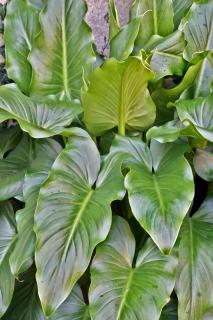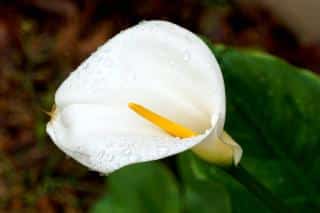

Calla lily, mistakenly called arum, is certainly one of the most beautiful bulb flowers.
Arum facts, a summary
Name – Zantedeschia aethiopica
Family – Araceae
Type – bulbous perennial
Height – 20 to 40 inches (50 to 100 cm)
Exposure – full sun, part sun
Soil – rich, well drained
Flowering – June to October
From planting to pruning, every bit of attention goes towards helping the growth and bloom of your arum. Follow our advice to produce magnificent arums!
Arum bulbs are planted at the beginning of spring, around 1 ½ to 2 inches deep, from March to May.
Alternate your arums with other bulbs that bloom in summer.
Water sparingly at the beginning and then more regularly once flowers have appeared, until the end of the blooming season.
Arum grows very well adjoining a body of water, which indicates how much it needs water.
Like all bulbs that bloom in summer, water in case of prolonged dry spells or heat waves.
For spectacular blooming, add special bulb plant fertilizer.

In areas that are prone to cold winters, protect the rhizomes with a thick layer of mulch. All airborne leaves may die off, but in spring they’ll grow back as lush and beautiful as ever! The mulch can either be a bed of dried leaves, hemp or flax straw, or ferns.
Tip: Before winter, dig out a portion of the rhizome and pot it in your house, and you’ll have arums in winter.
Once the leaves are completely yellow, you can cut them to the shortest.
You can also stow the bulb away without removing it from its pot, but the soil mix needs replacing every two years anyway.

Particularly exotic, it is perfectly suited to wet areas like water bodies and ponds, but is also the perfect plant for your flower beds, edges or standalone spots.
Even thought the spelling is arum, it is pronounced [uh-rome]!
These flowers are pure marvels, before the blooming is over, cut a few stems off and place them in a beautiful vase!
I love to grow nasturtiums but every time I do no matter where I plant them they get covered in black fly. I’ve tried bug sprays blowing them with water and all sorts to no avail . Can anyone help please?
I bought two arum lilies last year and planted in garden, they grew very well but no flowers. As I live in Devon the winters are not too cold so the leaves haven’t turned yellow, do I still need to cut them back or just leave them.
Hi Diane! You can of course leave them. If they weren’t damaged by frost, they will still remain very functional and help the plant grow. But if you feel they really look damaged, or simply find them too old and ugly, now is a great time to cut them off. New ones will grow back very soon, and that way you’ll have a fresh clump of leaves!
Hi Can you advise if I split my Arum Lilly. I have 2 at either side of a walkway and one is getting very big and was going to split it and plant the piece i take somewhere else. Is this possible and if so when is the best time to do it.
TIA
Marcella
Thanks for that. I’ll have to see what I have in my shed or what I can get hold of. I remember Dad using grapefruit skins as a deterrent, and he was always one for going out at night with a torch to see what was lurking under leaves etc.
All right! It’s true, grapefruit also works in a manner similar to the melon rind: slugs snuggle up inside to feed and then it’s easy to pick them off.
My arum lily has been badly chomped by either (I assume) slugs/snails. What should I put down to protect it? It did very well last year. It was taken from a plant my father had grown (now deceased) so I am rather upset.
Hi Susan! I understand your disappointment!
Since it’s already pretty well established, this isn’t yet life-threatening for your arum lily. Let’s see how we can keep that from happening.
First, make sure no slugs are hiding in, on, or under your plant. You don’t want to lock them in! Here is a page on using ashes to deal with slugs (snails is the same). Ashes are only effective until the next rain, though. Once they’re wet they don’t work. But there are also a few other techniques that can help.
– some plant mulch like flax mulch or cocoa hulls have sharp edges. This serves as a deterrent for a couple weeks. Just keep adding fresh handfuls every few days.
– Personally, I had a very severe infestation in my cauliflower patch once. I had to resort to picking the slugs manually early in the morning for a week until numbers started dropping. Fed them to chickens, they loved it!
– In parallel, I set up slug traps: an upside-down melon rind or slab of bark near the plant. The slugs will gather there in the morning to hide out during the day. Just pick the rind up in the morning and you’ll get rid of dozens of slugs at once!
– snails tend to hide there, too. Also can be found in trees and up nearby walls in the morning.
Slugs and snails come and go in the garden. If you set up a bird feeder, you’ll attract birds that will jump on any slug they can see.